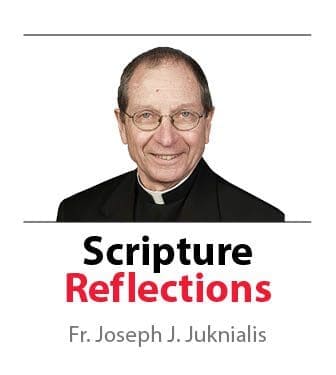Sixth Sunday of Easter
Acts 8:5-8, 14-17
1 Peter 3:15-18
John 14:15-21
One of my enduring insights into liturgical spirituality came unexpectedly from Msgr. Alphonse Popek, a professed traditional Milwaukee priest, who 45 years ago, resisted the liturgical reforms initiated by the Second Vatican Council.
In the late 1970s, Fr. John Brophy and I were assigned together as associated pastors to St. Catherine’s parish at 51st and Center streets in Milwaukee. At that time, he was also teaching sociology to students at what was then the new De Sales Seminary.
One evening, he came to dinner with a tape recorder and the invitation to listen to a recording of an interview of Msgr. Popek. Fr. Brophy had given his students the assignment to go out and interview a very conservative priest and a more progressive priest and then to write a report on their interviews. The tape he brought was that of one of his student’s interviews. As we listened to the recorded interview, Msgr. Popek described why many Catholics at that time took issue with the changes brought about by the liturgical reforms of the council.
God is both transcendent and immanent, he explained, which is to say that God is on the one hand so very much greater than we human beings, someone before whom we stand in awe, someone beyond us and incapable of being understood. On the other hand, he went on, God is also immanent, that is very personal, known intimately and as someone who always walks with us on the journey of life.
His point was that God is both. Yet, he continued to explain that if someone’s understanding of God tends to be primarily transcendent, such an individual would find the pre-Vatican liturgy much more prayerful. The Latin language, Gregorian chant, the formal attitude of the presiding priest, kneeling, silence, incense and candles – all of this created an other-worldly sense of mystery and awe before one’s God. Conversely, such an individual might find the new liturgical changes of that time akin to being almost blasphemous, or at least highly irreverent.
On the other hand, if someone’s understanding of God is primarily immanent, such a one would experience the new liturgical style initiated by the council as much more readily an experience of God’s intimate presence. A focus on the community, the use of the vernacular language as well as contemporary music, a more personal style by the presiding priest, the sign of peace, communion in the hand – all of this conveyed a God present with and among the assembled community. Such a person might also experience the more traditional style of liturgical prayer as aloof and distant and less prayerful.
That was the insight I came to see from Msgr. Popek — one’s liturgical preference often flowed from one’s spirituality relating to a God that seemed either primarily transcendent or primarily immanent. This despite the fact that in reality God is very much both transcendent as well as immanent.
The Gospel of this weekend describes one’s immanent experience of the Divine. God, says John’s Gospel, will “give you another Advocate to be with you always . . . you know him because he remains with you and will be in you . . . you will realize that I am in my Father and you are in me and I in you.” It is a God who is known personally and intimately.
Certainly there are other biblical passages that would describe the transcendent experience of God – Jesus who taught us to pray by saying “Our Father who art in heaven;” the Transfiguration when the disciples heard the voice of God and fell prostrate with fear; the power of God at the death of Jesus when the earth quaked and rocks were split and tombs opened and the soldiers who feared greatly at all of this.
The God of the Old Testament in many ways seems to be more transcendent than immanent. On the other hand, the God that Jesus proclaimed was a God who is among us and with us, who understands our struggles and fears and uncertainties because he has become one with us.
A young high school girl once described God as the river that flows through everything, and a middle aged man spoke of God like the warmth of the sun to be absorbed and comforting. Of the following images, which might best describe the God in whom you believe: gardener, Santa Claus, traffic policeman, baby-sitter, magician, judge, lover, artist, day dreamer, eye-in-the-sky, trickster, classroom teacher, cab driver. There are perhaps as many images of God as there are believers, all of which is part of the delight of coming to know God in our own lives.

